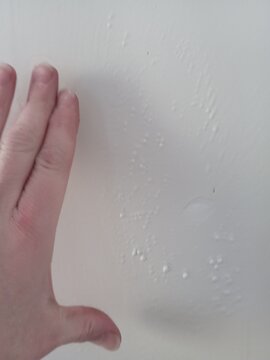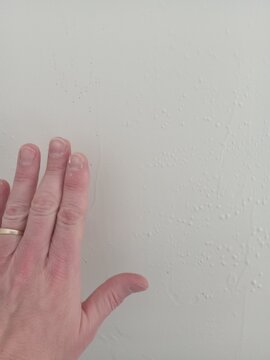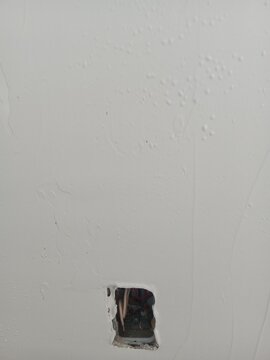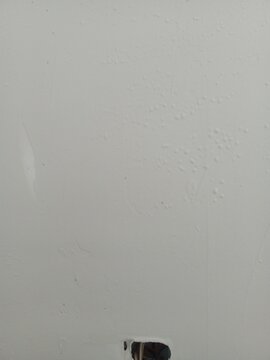Anybody ever hear of this?
Background:
I am remodeling our house built in '78. All drywall is 1/2" "basement board" - drywall with a tan paper surface, no pressed edges. Removed a bunch of painted paneling that was glued and nailed up. Figured to skim coat everything. Paper had some damage from paneling removal and scraping adhesive off. Peeled all loose paper & boogers off. Joints weren't taped under the paneling, so taped all joints & corners and coated with compound. That all went fine. Lightly coated areas with damaged paper with mud. Started skim coating (about 1/4 of the LR) and got a bunch of blisters at the damaged areas from the layers of paper separating. Looked closely at other damaged paper areas with light coating and they were blistered too. Cut blisters out, sealed everything with Guardz. Filled areas where the blisters were cut out, looked good. Second coated those areas and got TONS of surface air bubbles (Think chicken pox or measles). Tried more passes with the knife. Initially looked better, then bubbles again. Tried again, now I'm making a mess. Let it dry, scraped the bubbles, applied a super thin coat to fill the "pockmarks". Wasn't too bad. Grrrr...
Here's where it gets weird:
Started second coat of skim coat in the spot where I ended the first round of first coat; so part of the area has 1 coat of skim coat then sealer and part of the area has sealer and then 1 coat of skim. Everything where 2nd coat is directly on 1st coat has the really bad surface bubbles, everything where 2nd coat is on the sealer is fine... I don't understand why this would happen...?!?! 1st coat on the sealer is fine no matter of patch or skim coat. 2nd coat is bubbling no matter what.
Currently venting, researching and thinking... Former professional drywall taper BIL is stumped, GC friend is stumped.
Possibility #1... I am using pre-mix mud thinned down to be more workable. Did this same thing for 60+ gallons of mud on the Northwoods build - no issues. Have done it on other remodeling projects - no issues. Could the first coat be absorbing the moisture but not the air because of the sealer? Could the 1st coat be causing a boomerang effect of moisture and/or air because of the sealer? My next attempt (on a small area) will be mud straight from the bucket, no thinning... I have been advised that further thinning will probably make more bubbles.
Possibility #2... I could wait for what I did this morning to dry and put sealer over the rest of 1st coat. My concern is for finishing/sanding. If I sand through 2nd coat down to the sealer, how will it prime/paint? For that matter, if 2nd coat of mud is bubbling will the primer do the same?
In a nutshell...
Mud, sealer, mud - no bubbles
Sealer, mud, mud - bubbles
Anybody have any words of wisdom for me?




Background:
I am remodeling our house built in '78. All drywall is 1/2" "basement board" - drywall with a tan paper surface, no pressed edges. Removed a bunch of painted paneling that was glued and nailed up. Figured to skim coat everything. Paper had some damage from paneling removal and scraping adhesive off. Peeled all loose paper & boogers off. Joints weren't taped under the paneling, so taped all joints & corners and coated with compound. That all went fine. Lightly coated areas with damaged paper with mud. Started skim coating (about 1/4 of the LR) and got a bunch of blisters at the damaged areas from the layers of paper separating. Looked closely at other damaged paper areas with light coating and they were blistered too. Cut blisters out, sealed everything with Guardz. Filled areas where the blisters were cut out, looked good. Second coated those areas and got TONS of surface air bubbles (Think chicken pox or measles). Tried more passes with the knife. Initially looked better, then bubbles again. Tried again, now I'm making a mess. Let it dry, scraped the bubbles, applied a super thin coat to fill the "pockmarks". Wasn't too bad. Grrrr...
Here's where it gets weird:
Started second coat of skim coat in the spot where I ended the first round of first coat; so part of the area has 1 coat of skim coat then sealer and part of the area has sealer and then 1 coat of skim. Everything where 2nd coat is directly on 1st coat has the really bad surface bubbles, everything where 2nd coat is on the sealer is fine... I don't understand why this would happen...?!?! 1st coat on the sealer is fine no matter of patch or skim coat. 2nd coat is bubbling no matter what.
Currently venting, researching and thinking... Former professional drywall taper BIL is stumped, GC friend is stumped.
Possibility #1... I am using pre-mix mud thinned down to be more workable. Did this same thing for 60+ gallons of mud on the Northwoods build - no issues. Have done it on other remodeling projects - no issues. Could the first coat be absorbing the moisture but not the air because of the sealer? Could the 1st coat be causing a boomerang effect of moisture and/or air because of the sealer? My next attempt (on a small area) will be mud straight from the bucket, no thinning... I have been advised that further thinning will probably make more bubbles.
Possibility #2... I could wait for what I did this morning to dry and put sealer over the rest of 1st coat. My concern is for finishing/sanding. If I sand through 2nd coat down to the sealer, how will it prime/paint? For that matter, if 2nd coat of mud is bubbling will the primer do the same?
In a nutshell...
Mud, sealer, mud - no bubbles
Sealer, mud, mud - bubbles
Anybody have any words of wisdom for me?





